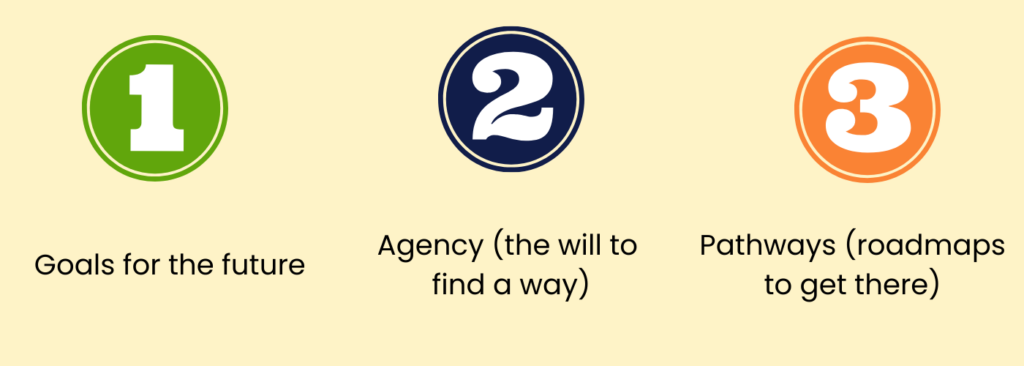
Protective factors strengthen a person or community and improve the chances of avoiding an illness such as a substance use disorder. These positive factors range from the personal—not having addiction in your family and therefore your genes—to much broader—such as growing up in a neighborhood where everyone looks out for one another.
One such factor is having hope—a belief that you have a role in a positive future, as well as the ability to get there. Hope has strong connections to well-being and can be measured and even increased. This month, Compass Mark spoke with public health professional Chris Glover about what hope is and how the skills of hope can be taught to young people impacted by family addiction.
According to Chris, there are three main components to hope:

Hope vs. Optimism
Hope is often confused with optimism, but the two are not the same. You are optimistic if you think the future will be better than the past. You are hopeful if you believe the future will be better than the past and you believe you have a role in making it so.
Hope is a way of thinking that involves action, whereas optimism is a feeling or belief. Since hope involves taking steps toward a goal, it is something that can be taught to both children and adults.
“Hope without action is a wish.”
Chris Glover
The Case for Hope
Researchers have found that people with high levels of hope report increased feelings of competence and self-worth, better physical and mental health, and higher levels of creativity. On the other hand, those with low hope experienced more depressive symptoms, anxiety, and self-doubt. Clearly, hope is part of the recipe for a healthy community!
Chris shared with Compass Mark that part of her healthy childhood foundation included regular, positive interactions with a caring neighbor. These after-school conversations and check-ins provided Chris with a stable adult who showed interest in her life. Although seemingly simple, acts such as asking a child about their day—and genuinely listening to the answer—are powerful interventions. Even one caring adult can buffer children from the impacts of chronic stress.
“When we experience failed attempts to achieve our goals, that is what results in the loss of hope.”
Chris Glover
In Chris’s case, she began to babysit for her neighbor every Saturday night, which offered dinner, some spending money, and a break from the tension in her own home. This relationship and routine increased Chris’s self-esteem and provided a sense of security—it was something she could count on, which has been shown to contribute to building hope. Chris’s neighbor didn’t try to solve her problems but did cheer her on, help her get clarity about her goals, and increase Chris’s ability to make plans for a brighter future.
Over 2,000 studies have shown that hope is the single best predictor of well-being. Even if we don’t have a neighbor like young Chris to nurture, we can have a positive impact on our own hopefulness and on others’. Learn more about the science of hope and how to measure and apply it. Practice both gratitude and goal-setting. Spend time with people who have high levels of hope and encourage others to do the same. Your hope is a protective factor that benefits your whole community!
“Addiction runs in families. So does hope.”
Joining Forces for Children, a program of Penn Medicine Lancaster General Health
About the Expert
Chris Glover is the Director of Adolescent Empowerment at Family Health Council of Central PA where she manages a public health prevention project that promotes positive adolescent development while advancing health equity for adolescents, their families, and communities. She was previously the Manager of Community Impact Initiatives at Penn Medicine Lancaster General Health where she oversaw mental well-being and substance-use-related projects, including Joining Forces for Children.
Chris relies on her background as a special education teacher, a non-profit administrator, and a public health professional while incorporating her family’s experience with addiction and recovery. As a natural advocate, she applies the science of hope to support others in their own recovery process. Chris is married, has an 18 year-old daughter, a 32 year-old step-son, and a 3 year-old granddaughter.
You’ll often see Chris with a smile on her face and cat hair on her clothes.
This post was originally published by WGAL TV 8 on www.wgal.com and sponsored by Donegal Insurance Group as part of the Mental Health Moment campaign. We thank WGAL TV 8 and Donegal Insurance Group for their support of prevention and mental wellbeing in our region.